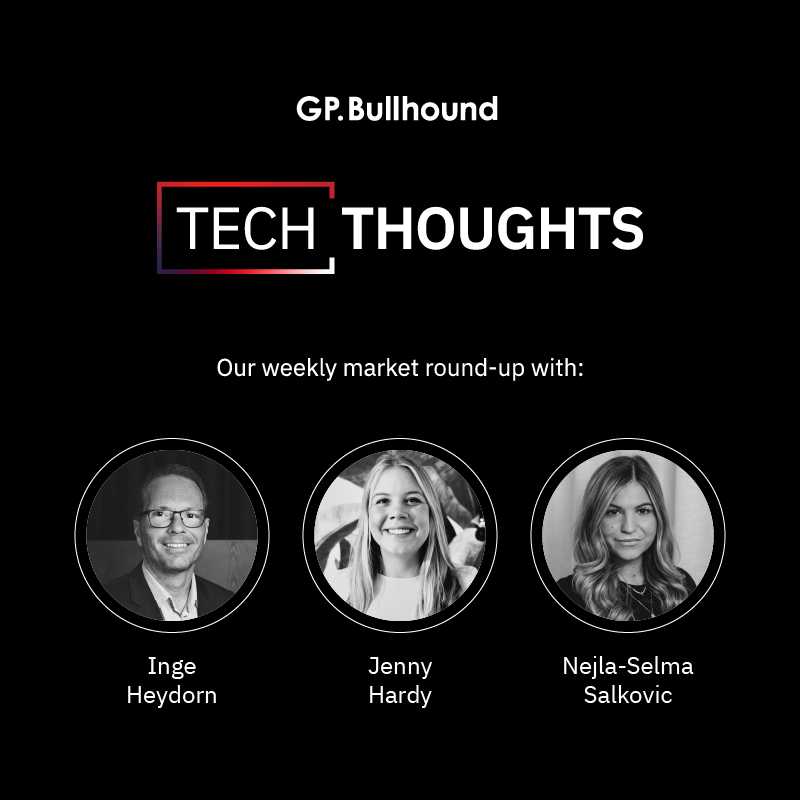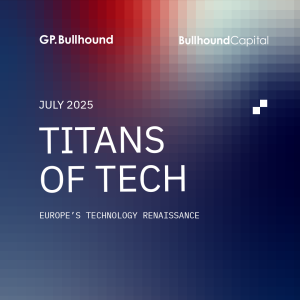Tech Thoughts Newsletter – 13 January 2023.

Conclusion
Most end markets have taken a further small step down in December and Q4 and the necessary inventory correction in consumer electronics is not over yet – it remains to be seen whether we’ll get a hoped for V-shaped recovery. Companies are unsurprisingly striking a cautious tone across the board, and we can’t imagine any CEO or CFO will miss acknowledging the macro uncertainty in upcoming results releases. It will be telling who will and who won’t issue firm guidance, and we look in particular for those companies with genuine earnings and cash flow visibility.
Portfolio
We have reduced our position somewhat in Lam Research due to strong performance of the shares and a worsening outlook for memory spend in 2023.
CES – the EV show
- CES is the largest tech show in the world, held in Las Vegas. While it’s still named “Consumer Electronics Show” it’s fair to say that it has morphed fairly significantly (and with less buzz) over the past several years, and arguably turned into more of an auto show, with traditional and new auto OEMs showcasing their latest EVs.
- For us as technology investors it’s all about the semi content increases moving from combustion engine to electric, and as auto OEMs increasingly try to differentiate with semi-heavy infotainment options.
- Staying on EV, Tesla’s Q4 shipments number disappointed vs expectations, despite price cuts, while the shipments out of Chinese OEMs Li Auto and Nio (two of many…) were up over 50% yr/yr. It feeds into our view that competition amongst the OEMs in the EV space is fierce, with pricing dynamics likely to continue to be tough. It’s the reason we avoid owning any auto OEMs, and instead opt to own the semi suppliers in the EV space, like Infineon and NXP, with better visibility and clearer competitive barriers to entry.
- Axcelis, which provides ion implantation solutions into the semi industry reported strong results, mainly on the back of SiC power devices into the EV sector.
Semis – working through inventories, product and tech upgrades hoping to drive H2 recovery
- TSMC (owned) reported its Q4 results which showed Q4 revenue decreasing slightly qtr/qtr, in line with expectations but with better profitability after cost cuts. Key for us was the outlook and the call commentary, as well as the capex guidance.
- Q1 was guided down 14% qtr/qtr – pretty much in line with what was expected. And 2023 was guided to still be a growth year.
- Commentary is around a weak macro and weakening end markets – including now datacentre. Inventory has peaked in Q3 (consistent with what we heard from other players) and is now declining – that will continue through H1, before a “V-shaped” recovery in H2, driven by more normalised inventory, and new product launches in HPC, as well as their 3nm ramp.
- While we’re always sceptical about H2 weighted growth (for any business), demand for TSMC’s 3nm (HPC and Apple) clearly exceeds supply and will be fully utilised in 2023, starting in Q3 – that should contribute well over 10% of H2 revenue and on our maths should drive a ~25% H2 vs H1 growth.
- Positively for our holdings in Infineon and NXP, the one area of strength that TSMC pointed to was auto demand which is still increasing, and supply is still tight.
- TSMC’s capex guide was key for us – especially for our holdings in ASML and KLA – and they guided to $32-36bn from $36bn this year which we think is within a good enough range (as well as their Q4 spend at $11bn being very robust and boding well for reported Q4 numbers). 2nm, which will use ASML’s new high NA tools, was said to be progressing better than expected.
- One good stat to call out – TSMC stated their fab construction costs as 4-5x larger in US vs Taiwan.. If there was any doubt that the decision to build out in the US was anything other than politics.
- Memory is a less comfortable space – Micron’s report before Christmas was weak (and the call made for tough reading – “The industry is experiencing the most severe imbalance between supply and demand in both DRAM and NAND in the last 13 years”). Though they did note they expected inventory levels to normalise by mid calendar 2023. Samsung’s Q4 last week was similarly weak with a 70% yr/yr decline in net profit.
- Micron emphasised its capex cuts for this year and next, while Samsung remains the big unknown in terms of memory spend and supply. Historically it has continued to spend through weaker market environments, and it has also made commitments to its foundry tech leadership. We expect it might still hold off offering guidance even at its full results release at the end of the month, which will leave a degree of uncertainty in the space.
- Ichor sells into the semicap equipment space warned around weakness in memory too. We have reduced our position in Lam Research. VAT Group too, who sells valves into the memory tools space, reiterated a softening market environment. We suspect there is an inventory correction going on in the sub-supplier space, after shortages through the year likely led to some over-ordering from their customers (the semicap equipment players).
- December sales numbers have been coming out of Taiwan over the last couple of weeks, with some seasonal volatility post holiday builds and also we think some unusual behaviour related to Apple and the production impacts in China, so we’d caution not straightforward reads. Mediatek were solid again in December showing a month/month increase, hopefully reflecting that view of normalising inventories.
- UMC too was fine – down slightly month on month but still showing growth yr/yr
- Delta (Infineon customer) monthly numbers were impressive again – it’s power business up 56% yr/yr, which bodes well for Infineon.
- Realtek (which sells components into Notebooks) reported weak December sales numbers (-30% yr/yr). IDCs Q4 data showed PC shipments at their lowest level since 2018.
- Marvell reconfirmed its Q4 guidance as it announced a CFO transition – it had guided for a Q4 decline driven by weaker storage and enterprise, offset by stronger auto, 5G and cloud, so while things might not have got better, they also haven’t got worse since they reported at the start of December.
China reopening
- The China reopening has continued over the past month or so. While there are rumours COVID cases are peaking there is still limited real data and with Lunar New Year around the corner there are clearly significant worries that the situation could still deteriorate.
- The economic data so far has remained weak. China exports in December declined 10% yr/yr, the biggest drop since February 2020…
- It seems clear to us that all businesses with China exposure will experience some impact – Unsurprisingly, both Nvidia and Analog Devices made comments related to weaker demand in the quarter from China at CES.
- From an Apple production perspective there was news that the Foxconn factory which had been impacted was brought back to 90% capacity (and December sales were up 14% mth/mth), which means that some of the worst case scenarios around Apple’s Q1 should be avoided.
Microsoft and the AI buzz (or bubble?)
- Microsoft CEO Satya Nadella gave an interview in which he talked of a challenging 2 years ahead. We agree that the pause/optimisation of spend we saw from all the cloud providers in Q3 is likely to persist, but do see that as healthy for the long term picture of cloud. Operating workloads on cloud is 80-90% more efficient than owning and operating your own datacentre – the long term incentive to shift workloads will play out over time.
- Longer term he talked of AI as the next paradigm (post cloud and mobile). Following that interview, reports emerged that Microsoft is in talks to invest $10bn in OpenAI at a hefty $29bn valuation (it had already invested $1bn in cash and Azure credits in 2019). The implications for Microsoft and its products (Search, Office..) could be significant longer term, but shorter term the potential impact on the growth of Azure is probably the most relevant, and might be a clearer driver of Microsoft’s interest.
The perils of being an Apple supplier
- Bloomberg reported that Apple is designing an in-house chip that will replace the WiFi and Bluetooth chip it currently uses from Broadcom (where we own a small position), and possibly the cellular chip it uses from Qualcomm too. This isn’t really new news – Apple has been trying (and struggling) to in-source its connectivity chips for some time – and the standardisation required within connectivity makes it a less straightforward problem arguably even than processor chips. We wouldn’t be surprised to see this delayed again.
- This was followed later in the week with reports that Apple will also start making its own displays, replacing LG Display and Samsung. This is surprising to us, given the broadly commoditised nature of display and OLED (where we don’t have any exposure).
Indian IT services largely better with increasing cost take-out projects from customers
- Tata Consulting and Infosys both delivered solid results in the IT services space, with Infosys even upgrading guidance slightly. Both spoke of an accelerated client focus on cost take out/rationalisation, which they’re benefitting from, in spite of delayed decision making in longer term projects. In the details Europe continues to be (surprisingly?) strong, with strength in manufacturing and energy and softness in retail (no surprise).
- Cognizant announced a leadership transition with former Infosys president Ravi Kumar joining the firm as CEO succeeding Brian Humphries who will remain with the company as a special advisor until March. The company also updated it 4Q guidance lifting sales slightly, while EPS is revised down due to an impairment of capitalised costs related to a large volume-based contract with a Health Sciences customer.
- HCL 3Q sales grew 20% yr/yr and they expect 4Q sales to grow 13,5-14% in constant currency – a slight downgrade from earlier projection of 13.5-14.5%.
- The company said the total contract value of new deals rose 10% from a year earlier to $2.35 billion for its third quarter.
2023 seeing further headcount cuts
- Across the board tech firms are continuing to announce headcount reductions. Marc Benioff has been very explicit about falling sales productivity and the fact that they hired too many people through the pandemic.
- Indeed in the same interview as above, Nadella talked about more scrutiny around sales efficiency.
- In our analysis we can see a huge variation in terms of sales productivity and some businesses which to us look unsustainable.
Early software warning
- Darktrace (Cyber security) was out with one of the first warnings in the software space, reducing its guidance for revenue on weaker new customer growth. We continue to think that niche cyber security software is vulnerable to provider consolidation. Darktrace has the additional problem that it relies on new customers to replace high churn levels – a dynamic that we think will leave companies very vulnerable in this particular period.
Streaming content wars continue
- The run up to Christmas saw a couple of interesting developments in streaming: firstly YouTube signed an agreement for exclusive rights to the NFL Sunday Ticket franchise at $2bn a year. It will be offered as both an add on to YouTube TV and via its YouTube Primetime Channels (which is effectively a . It’s very hard to get the unit economics here to work, but again it reinforces the idea that for big tech (it was rumoured to be Google and Amazon fighting out at the end), streaming is strategic, and for YouTube/Google is likely more of a push to get its platform onto TV screens, and indeed move from ad supported videos to more paid content.
- Elsewhere in streaming, third party data suggested Netflix’s new ad supported plan had proved fairly unpopular and had fallen short of viewership guarantees for its advertisers. There are puts and takes here – customers not choosing to downgrade, but more (cheaper?) ad tiers probably necessary from Netflix to really drive uptake. The last part of the year saw popular releases, which should help subscriber numbers in Q4.
Gaming – title driven and execution key
- Ubisoft issued a profit warning after a number of disappointing releases in the quarter. It has been historically poor at building recurring revenue models on key franchises like Assassin’s Creed, Far Cry, and its Tom Clancy games.
- The company is cutting its booking guidance for the full year to EUR725m down 10% Y/Y from earlier guidance of EUR830, due to weak demand, releases and the delay of their game Skull and Bones. Operating income is expected to be negative EUR500m instead of a gain of EUR400m, driven by the lower top line and higher depreciation of R&D of EUR500m. The EUR400m operation income target is moved forward a year to 2023-24.
- The gaming market had continued to be weak in 4Q with the exception of some of the key mega releases like Call of Duty and Gods of Ragnarök and we continue to selectively own these blockbuster game developers with strong franchises.
Mixed data points in consumer and retail.. Logitech profit warning
- Adobe reported its online holiday sales which showed solid demand across toys, video games and apparel – helped by heavy discounting from retailers.
- Logitech issued a profit warning Thursday morning which showed the vulnerabilities – from both a supply and demand perspective – retailers are set to experience this year. They are expecting sales to only reach USD1.26-1.27 billion down between 17-18% yr/yr in constant currency. Challenging macroeconomic conditions including a slowdown in sales to enterprise customers in the quarter hurt.
- The outlook is also cut due to the uncertainty around supply availability from China. The company now expect sales to be down 13-15% yr/yr during 2023 an adjustment down from earlier expectation of down 4-8%.
- Operating income in the quarter will total USD198-203m down 33% Y/Y. Management states that they will try to manage costs going forward.
For weekly insights on the latest market updates, please subscribe to our Tech Thoughts podcast.
For more information about Tech Thoughts, please visit https://www.gpbullhound.com/tech-thoughts/.
We provide investors with access to category leading technology companies, globally. Our assets under management have a total value of more than €1bn, and our limited partners include institutions, family offices and entrepreneurs. Learn more about our funds here.
Enquiries
For enquiries, please contact:
Inge Heydorn, Partner, at inge.heydorn@gpbullhound.com
Jenny Hardy, Portfolio Manager, at jenny.hardy@gpbullhound.com
Nejla-Selma Salkovic, Analyst, at nejla-selma.salkovic@gpbullhound.com
About GP Bullhound
GP Bullhound is a leading technology advisory and investment firm, providing transaction advice and capital to the world’s best entrepreneurs and founders. Founded in 1999 in London and Menlo Park, the firm today has 12 offices spanning Europe, the US and Asia. For more information, please visit www.gpbullhound.com.



